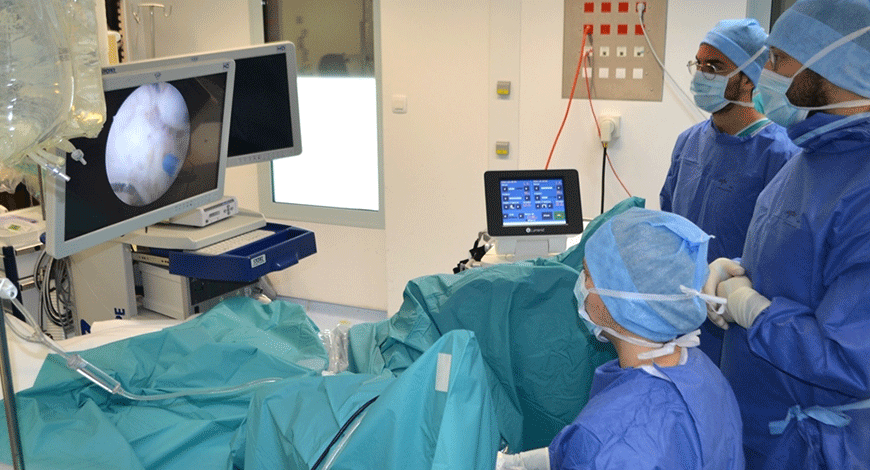Devices & Utilities
The gold standard for laser lithotripsy

Lasers are one of the safest tools in urology, and newer developments in this technology will allow further minimization and increased efficacy and safety of urological procedures with exciting new developments in the future.
The prevalence of kidney stone disease has increased in the modern era due to the effects of increasing obesity, diabetes, and changes in dietary habits on urinary stone formation. In this new Stone Age, while minimally invasive therapies remain the mainstay of treatment, there has been a notable increase in the use of ureteroscopy (URS), so that URS is now the most common surgical therapy for upper urinary tract stones. One reason for the shift in practice toward URS has been the widespread availability of the holmium laser, which permits lithotripsy in all stone locations, regardless of stone composition. With the propagation of more powerful higher-watt holmium systems and advances in laser technology, the options available to surgeons for laser settings and techniques to break up stones have expanded. Modern-day holmium laser systems for ureteroscopy provide users with a range of settings, namely, pulse energy (PE), pulse frequency (Fr), and pulse width (PW). These variables allow the surgeon to choose different combinations that have specific effects on stone fragmentation during URS lithotripsy.
Presently, several high-power holmium laser systems are available, and these are capable of attaining much higher pulse energies (up to 6 J), very high pulse frequencies (up to 100 Hz), and higher total power levels (up to 140 W), thereby overcoming past limitations (46–50). These higher frequencies enabled a new laser lithotripsy philosophy, namely, the ability to dust urinary stones quickly and efficiently, avoiding the need for capricious and time-consuming maneuvers associated with the removal of residual stone fragments.
The same progress that resulted in more powerful holmium laser lithotripters also led to the development of a third parameter for the surgeon to manipulate, the ability to control the pulse duration (i.e., pulse length) and pulse shape, with consequent reduction of stone retropulsion and laser fiber-tip degradation. Besides the standard short-pulse mode, one can currently choose medium-, or long-pulse modes, depending on the holmium lasers model.
Another special feature for further reduction of stone retropulsion and increase in ablation rates has recently become available, and was termed Moses technology by the holmium laser manufacturer Lumenis. It consists in delivering a short, low-energy pulse to create a vapor bubble before delivering the actual ablative energy pulse. Other holmium laser manufacturers also utilize similar techniques but use different terms and trade names, such as stabilization mode, vapor tunnel, or virtual basket technology. Pulse modulation has also been developed for holmium lasers and this was shown to deliver better quality dusting. This results in finer fragments for clearer vision during the procedure, and is valuable for effective clearance and suction techniques, both in current practice and in development. Pulse modulation also results in less retropulsion for easier utility of the laser device.
Multipulse sequencing has improved the quality and speed of fragmentation, with better results than long-pulse techniques. Future holmium laser technologies aim to optimize this effect, with the development of pulse trains of rapidly repeated, similar-energy pulses that aim to avoid the risks of prolonged energy durations, without sacrificing the efficacy of high power. Developments in the technology have not ended, with other customized approaches to laser pulse delivery, such as burst laser lithotripsy as well as even more powerful and feature-rich holmium laser lithotripters on the horizon.
This gradual and continuous holmium laser evolution, with the ability to ablate any type of urinary stone, and the capacity to cut, coagulate, ablate, enucleate, and vaporize tissues, as well as the technology’s excellent safety profile, make holmium laser the safest, most versatile, and most successful type of laser currently used in urology.
Holmium laser – An emerging trend
 Karan Sharma
Karan Sharma
Managing Director,
Allengers Global Health Pvt. Ltd.
The history of urinary stones almost begins and goes parallel with the history of civilization. But electrohydraulic lithotripsy was the first modern intracorporeal lithotriptor invented in 1954 by Yutkin, an engineer from Kiev. Since then, there has been a phenomenal change in how urinary stones are treated.
Improvements in intracorporeal lithotripsy also allowed renal stones to be treated by percutaneous renal surgery.
With subsequent developments in endourology (like laser lithotripsy), the ongoing search has resulted in better than percutaneous surgery, and intracorporeal lithotripsy (ESWL). The procedure of ESWL takes about 1–3 hours per sitting and all compositions of stones cannot be treated with it.
The holmium laser lithotripsy treatment can be done without any incision within a single sitting, resulting in a shorter hospital stay and faster recovery for the patient as post-operative recovery is minimal.
-
Holmium laser has the following advantages:
-
Holmium laser can break up all kinds of compositions of stones.
-
The dusting effect achieved from high frequency holmium laser results in the ability of the sediments to pass through the urinary tract naturally.
-
A single sitting can result in the discharge of patient within 24–48 hours, thus reducing ICU bed number requirements of the hospital and better patient care.
-
Higher-watt holmium laser can also be used for fine cutting of prostate and small tissues.
There is no risk and complication associated with the holmium laser procedure.
In case of RIRS/URS procedure, a flexible/rigid endoscope or cystoscope is used to reach the stone in the kidney, ureter, or the bladder, through the urinary tract. Laser waves are then directed onto the stone to break it into small fragments or dusting.
Holmium laser enucleation of the prostate (HoLEP) has been introduced to relieve bladder outlet obstruction caused by benign prostatic hyperplasia (BPH). Compared with other techniques, including the transurethral resection of the prostate (TURP) and simple open prostatectomy, HoLEP through holmium laser results in better cutting and less blood loss. Holmium laser HoLEP is an easy and safe technique in patients with a prior history of prostate problem and a need for retreatment.
Thus the holmium YAG laser possesses both ablative and hemostatic properties and in preliminary clinical use, it has demonstrated many potential urologic applications.
The global urology medical lasers market is expected to grow from USD 0.871 billion in 2020 to USD 0.917 billion in 2021 at a compound annual growth rate (CAGR) of 5.3 percent. The growth is mainly due to the companies resuming their operations and adapting to the new normal while recovering from the Covid-19 impact, which had earlier led to restrictive containment measures involving social distancing, remote working, and the closure of commercial activities that resulted in operational challenges. The market is expected to reach USD 1.148 billion in 2025 at a CAGR of 6 percent.
One of the major factors driving the market for urology lasers is the adoption of minimally invasive surgical techniques in holmium systems as well as thulium laser treatment systems. These systems offer several advantages, such as greater effectiveness, safety, and quick recovery, which has resulted in increased demand for holmium and thulium systems. These systems have provided successful outcomes while minimizing the side effects of treatment, and offer advantages, such as shorter hospital stays, quicker recovery, reduction in blood loss, and lower overall body pain as a result of smaller incisions. Thus, the effectiveness and safety characteristics of these systems are expected to drive the growth of the market.
Some of the major players in the global urology medical lasers market include Allengers, Olympus Corporation, Ethicon, Inc., Stryker Corporation, Boston Scientific Corporation, Richard Wolf GmbH, Cook Medical Incorporated, Karl Storz GmbH, and Lumenis Ltd.
While holmium lasers have been widely employed over the last two decades, in recent years, there has been a surge of interest in thulium fiber laser (TFL), which offers theoretical advantages of better water absorption and lower stone ablation thresholds. The thulium laser segment is expected to register the highest CAGR over the next five years owing to its advantages over transurethral resection prostate (TURP), a traditional method.
Thulium lasers represent the leading competitor to holmium lasers for laser lithotripsy, with an emergence of studies in recent years supporting their efficacy and comparing their clinical utility to their holmium laser predecessors.
The holmium laser apparatus utilizes a resonance chamber for energy amplification, and requires a large cooling mechanism, thus resulting in bulky machinery, weighing up to 300 kg. The thulium laser amplifies within the fiber itself, so it does not require a resonance chamber, and can be cooled with a simple fan; this results in an apparatus that is much smaller and lighter, weighing 35–40 kg, 7–9 times lighter, and 8 times smaller than the holmium machine.
In comparing the clinical results of the two lasers, it is evident that the fragmentation capability of the thulium fiber laser is faster than that of the holmium laser; the thulium laser fragments stones twice as fast as the holmium laser and completes dusting up to four times as fast. Recent study results found that the thulium laser had faster ablation on every setting and for all stone types. The thulium fiber laser was also found to produce a higher quantity of smaller dusting particles during ablation, which contributes to clearer field of view and ease of suction clearance.
Recent research has highlighted the impact of collateral thermal injury from the use of lasers in renal stone ablation. Dr Evangelos Liatsikos, Patras, Greece, in a recent conference has clarified the risks associated with both holmium and thulium laser systems in lithotripsy. Higher energy, while contributing to speed and efficacy of ablation, generates higher heat, particularly in the presence of low irrigation. The threshold for cellular injury is 43°C; this threshold is reached within the first one second of laser use and returns to normal temperature levels over five seconds following laser cessation. Dr Liatsikos highlights the surgical circumstances associated with greatest risk of thermal injury – low irrigation (passive or gravity irrigation), higher laser energies, and instrument use without an access sheath. For clinical safety, he reports that research analysis recommends that irrigation should be >100 mL/min for powers >30 W and that laser power >100 W cannot be recommended.
Holmium lasers balance stone and water energy absorption to be safe and effective for fragmentation of renal stones, when in both direct contact and at a distance. Thulium pulse lasers show excellent promise for more efficient renal stone ablation and have practical improvements over bulky holmium lasers; however, the thulium alternative does not have the foundation of evidence and experience that the holmium laser systems have established over the past two decades. Both laser systems present risks of thermal injury that have been historically underappreciated but are important immediate clinical considerations and are influencing the technological advancements of the lithotripsy systems in development.
Holmium laser has stood the test of time; it has been extensively studied and has become the gold standard for laser lithotripsy since its first appearance over
30 years ago.
Holmium laser has stood the test of time; it has been extensively studied and has become the gold standard for laser lithotripsy since its first appearance over 30 years ago. Nevertheless, the apparent advantages of the TFL over the holmium laser (several times higher efficiency, wider and more comprehensive parameter combinations, significantly reduced retropulsion, ease of use, versatility, scope miniaturization possibilities, system compactness, foreseeable component durability, and increased safety profile) are simply too extensive to be ignored. The TFL appears to be a real alternative to holmium laser, with the potential to become a true game changer in laser lithotripsy. Due to its novelty, further studies are needed to broaden understanding of the TFL, and comprehend the full implications and benefits of this new technology, as well its limitations.











